WASHINGTON ― What mattered was that he showed up — that he put himself in front of the people whose opinions on the arcana of U.S. fiscal policy would have a direct and immediate impact on his weakening body. The point was for them to see his frailties, hear the catches in his voice and the kludginess of his diction.
Perhaps then they would understand that they were voting on the question of whether to kill Ady Barkan.
The massive Republican tax bill that sped its way into law these past few weeks has at times seemed like a blur of obscure details ― rates, deductions and exemptions ― decipherable only to accountants and seasoned policy wonks.
But in two face-to-face conversations with key Republican senators, Barkan, a 34-year-old progressive activist diagnosed just over a year ago with ALS, or Lou Gehrig’s disease, managed to boil the technocratic debate down to the straightforward life-and-death questions at its center.
Days after a Dec. 7 airplane conversation about the bill with Sen. Jeff Flake (R-Ariz.) that quickly went viral, Barkan flew back to Washington, D.C., from his home in Santa Barbara, California, to take one last shot at killing the legislation ― this time with the help of his wife, Rachael King, and their 18-month-old son, Carl.
Barkan was once an energetic young dad who took runs on the beach and hiked in the mountains, but ALS, a terminal illness that paralyzes its victims over time, has slowly deprived him of his strength. He can’t pick Carl up, and his movements have become more awkward and constrained, his voice softer and more slurred than it once was. He usually just needs a cane to walk, but on Dec. 13, a day of activism against the Republican tax bill on Capitol Hill, he opted for the extra support of a wheelchair.
Barkan and hundreds of like-minded activists had centered their opposition to the tax bill on the cuts it could generate to essential social programs. They feared the tax bill’s addition of $1.4 trillion to the debt would trigger pay-as-you-go, or “Paygo,” rules ― resulting in across-the-board spending cuts to programs like Medicare that Barkan will depend on as his disease progresses. Specifically, Barkan will need an expensive ventilator and the near-constant help of professional medical staff in the coming years.
While Congress wound up waiving Paygo, critics believe that the budget hole created by the tax cuts will generate enormous pressure to cut Social Security, Medicare and other public benefits. House Speaker Paul Ryan (R-Wis.) has said that slashing these programs is next on his agenda.
And the tax bill’s elimination of the Affordable Care Act’s individual mandate is due to destabilize insurance markets and add 13 million people to the ranks of the uninsured.
“The chasm between elites and ordinary people is really about the extent to which elite people make decisions without really consulting with the people who are affected by those decisions.”
- Andrew Levin, Dartmouth College
Upon his return to Washington, Barkan rolled into the office of Sen. Susan Collins (R-Maine), accompanied by a delegation of the state’s activists, for a meeting they broadcast live on Facebook.
When Collins arrived, Barkan grew solemn. Each member of the group went around the table describing his or her acute health care needs and fears about the changes the massive tax cuts could set in motion.
Collins listened intently. When pressed about Paygo, she repeatedly reassured the activists that she had secured a written promise from Republican leaders in Congress that Paygo rules would be waived.
Barkan and the other activists argued that Republican leaders could break their promise, much as they did the promises to hold the middle class harmless in the tax bill and not add to budget deficits. (Reducing tax deductions, including the state and local tax deduction, in the bill is expected to result in a net tax increase for millions of middle-class households.)
“I believe the commitments that I’ve received,” Collins responded when challenged.
That’s where Barkan lost it. Up to that point, he had been speaking in a gentle timbre, but the thought of entrusting his well-being to a pinky promise from Senate Majority Leader Mitch McConnell (R-Ky.) was too much.
“I know,” he said, the strain audible in his voice, “but it’s my life on the line!”
The meeting ended without a resolution. Collins wound up voting “yes.”
It was a defeat, but at least Barkan had made the stakes of her decision plain, both to the senator and to the many Americans following the run-up to the vote. This was a vital sort of activism in every sense of the word. Not for the first time, Barkan had reduced the dispassionate interplay of American politics to its moral essentials.
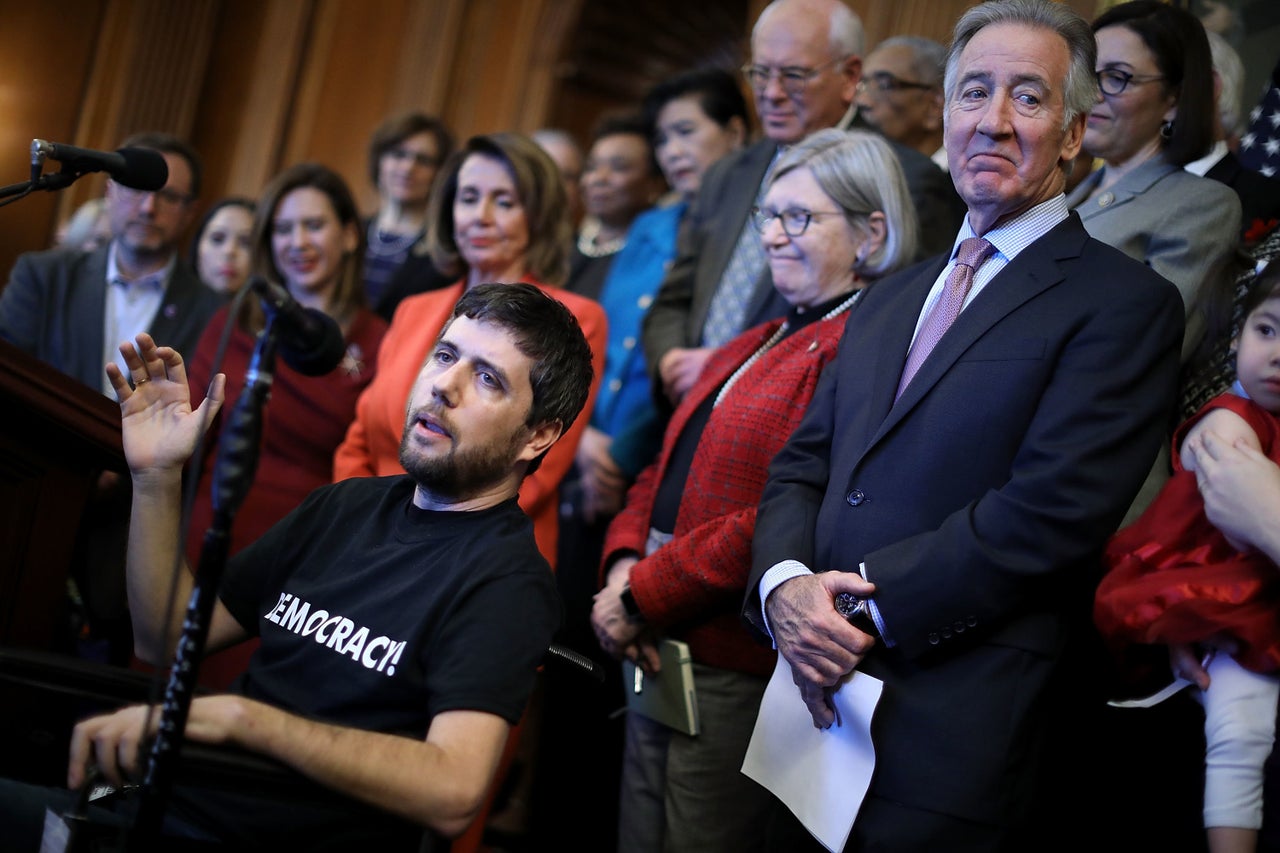
Introducing The Experts To The People They Serve
In the United States, technical expertise is rightly prized. But just as a doctor must consult a patient and patient’s family before performing an important procedure, so too must the experts who run the American government and economy listen to the feedback of the people whose lives they are shaping.
The present populist moment in American politics reflects the fact that ordinary Americans on the right and the left no longer feel that the doctors are listening to the patients. All too often, they are not even sure how to start a conversation.
“The chasm between elites and ordinary people is really about the extent to which elite people make decisions without really consulting with the people who are affected by those decisions,” said Andrew Levin, a Dartmouth College economist who has collaborated with Barkan and was a longtime economist at the Federal Reserve. “And that chasm not only includes people on Wall Street and in the financial system, but also people in academic institutions and think tanks, as well as government officials who make decisions behind closed doors.”
Barkan’s personalized style of activism, which centers on the stories of individual people as opposed to the abstract possibility of a policy’s fallout, is one way of addressing that alienation. And he honed it by innovating an entire field of advocacy around an institution far more secretive than Congress, and an issue far more arcane than taxes.
The principal accomplishment of Barkan’s career has been to turn the Federal Reserve, a central bank whose far-reaching influence few Americans understand, into a major battleground for progressive ideas. It’s a feat he managed much in the same way that he turned his Capitol Hill lobbying into a national news story: by educating people about the impact of the Federal Reserve’s monetary policy on their lives, and mobilizing them to confront the elites who craft that policy.
As a new staff member at the New York-based Center for Popular Democracy, Barkan conceived of, built and nurtured the Fed Up campaign, a grassroots movement to pressure the Fed to enact monetary policy that reflects the needs of all workers, especially low-income workers and people of color. Veteran progressive activists and economists now consider Fed Up one of the most effective economic justice initiatives in a generation.
“Fed Up is trying to push for real engagement and push for real transparency and accountability,” said Levin, who was a special adviser to Fed chairs Ben Bernanke and Janet Yellen. “They call it grassroots because it is engagement between real people, ordinary people, and elite leaders who aren’t used to having that kind of engagement very often.”

The Federal Reserve is a notoriously elite and secretive institution that has long been viewed as a purely technocratic entity that exists at a necessary remove from the realm of grubby politics. A famous book about the Fed published in 1987 was titled Secrets of the Temple.
But in reality, the Fed is a highly political body shaped by the balance of power and prevailing ideological winds in the country at any given time. Its decision-makers are typically drawn from the ranks of financial institutions and the upper echelon of university economics departments. And the elite backgrounds of those Fed officials color how they weigh tradeoffs between the interests of investors and workers when deciding whether and how much to adjust key interest rates.
The Fed has a dual mandate obligating it to adjust key interest rates in a way that both keeps prices stable and maximizes employment. Lenders use the Fed’s federal funds rate, which dictates the interest that banks charge one another for overnight lending, as a benchmark for other types of credit. When the Fed decides that employment has reached a level that is likely to spark higher-than-ideal inflation, it raises the federal funds rate to increase borrowing costs throughout the economy and eventually slow down the job market.
Bankers like low inflation because it preserves the value of the debts owed to them, whereas slightly higher inflation that accommodates a hotter job market is to the greater advantage of workers.
Raising rates is “not a benign tradeoff,” said Jared Bernstein, a senior fellow at the liberal Center on Budget and Policy Priorities who previously served as an economic adviser to Vice President Joe Biden. “It’s one that very much rewards asset holders versus paycheck holders.”
That’s why progressive economists have long criticized “the unrepresentativeness” ― or elite, non-diverse backgrounds ― of Fed officials, which has biased them in favor of asset holders, according to Bernstein.
But no matter how many policy papers Bernstein and his colleagues would publish showing that the Fed was too squeamish about inflation and too sheltered from the challenges facing ordinary workers, liberal criticism of Fed policy largely remained obscure. At the same time, the economic right had the benefit of high-profile conservative politicians using their national platforms to make the opposite point.
Then Barkan stepped in, marshaling for the first time a network of grassroots activists who could bring to life the arguments of progressive economists and force the Fed to confront the impact of its decisions on predominantly low-income communities of color. These activists told Fed officials that the economy had not yet recovered for them, and demanded to know why they would even consider raising rates under those circumstances.
All of a sudden, the issue was not arcane anymore. By putting a human face on the Fed’s decisions, Barkan’s work at Fed Up finally prompted the larger progressive movement to see the relevance of the discussion. And it provided at least some counterbalance to the views of financiers and business executives with whom Fed officials are typically in more frequent contact.
“We’ve written academic papers and we’ve complained about some of the metrics they used, but [Barkan] did something about it and has been way more influential than people realize,” Bernstein said.
“I have been in Washington, D.C., for a quarter-century, and this is one of the few things I have seen that I can say has had a real impact.”
- Dean Baker, Center for Economic and Policy Research
Dean Baker, a co-director of the Center for Economic and Policy Research, a progressive think tank that has supported Fed Up’s efforts, called Barkan’s efforts “really impressive.” Baker was part of a smaller, short-lived effort by labor unions and progressive economists to reform the Fed in the 1990s. But it never quite took off the way Fed Up did.
“I don’t think many people could pull that off,” Baker said. “I have been in Washington, D.C., for a quarter-century, and this is one of the few things I have seen that I can say has had a real impact.”
As a graduate of Yale Law School, Barkan eschewed a lucrative career, opting for a life of activism that landed him in 2012 at the Center for Popular Democracy, a foundation-backed network of low-income grassroots advocacy organizations. He came to the job with experience fighting wage theft at the immigrant rights group Make the Road New York, and after a year clerking for former federal Judge Shira Scheindlin, a civil libertarian known for striking down the New York City Police Department’s “stop-and-frisk” policy in August 2013.
At the Center for Popular Democracy, Barkan was initially tasked with running Local Progress, a board of local progressive lawmakers.
He took to his duties with gusto. But a 2011 essay by Matt Yglesias arguing that progressives should focus more on the makeup of the Federal Reserve inspired Barkan to consider what a left-leaning Fed activism movement might look like.
Barkan saw a clear link between the Federal Reserve’s decisions on interest rates and CPD’s work organizing communities of color to agitate for policies that improved their lives. He read the work of economists who argued that small changes in levels of employment disproportionately affect workers of color, who are often only able to overcome employer discrimination when demand for their labor is so high that employers have no choice but to hire them. In good times and bad, black working-age people suffer from roughly twice the unemployment rate of their white peers, but when the job market improves, black unemployment also goes down at about twice the rate of white unemployment, according to data by the Center for Economic and Policy Research.
Taking on the Fed as a progressive cause, Barkan said, “inspired me because I believe we should have an economy where everybody should have a good job and good wages and be treated fairly and live in dignity, because we have too much racial inequality in this country … and because government should be accountable to the public, and the Federal Reserve is accountable to the banks.”
Barkan began privately sounding out liberal economists about the feasibility of refocusing attention on the Fed to advance the fight for economic and racial justice. Baker cited an email exchange in which Barkan had inquired about it back in September 2012.
“He was putting together the pieces and asking, ‘Can we do this?’” Baker remembered.
Barkan approached the leaders of the Center for Popular Democracy about launching a campaign to pressure the Fed later that year.
“Our response was like, ‘Wow, this is a great idea that will never happen,’ because it was so hard to imagine grounding such a wonky analysis and target with the imperatives of building real community ownership and commitment to the issue.”
- Andrew Friedman, Center for Popular Democracy
They expressed interest in the policy component of Barkan’s proposal ― and extreme skepticism that any such campaign could ever develop traction with grassroots activists.
“We love and respect Ady, so our response was like, ‘Wow, this is a great idea that will never happen,’ because it was so hard to imagine grounding such a wonky analysis and target with the imperatives of building real community ownership and commitment to the issue,” recalled Andrew Friedman, the co-executive director of CPD, who worked closely with Barkan at Make the Road New York.
Friedman and his colleagues challenged Barkan to explain how he could make the campaign resonate with the low-income communities of color that CPD served, never expecting Barkan to develop a presentation compelling enough for CPD to devote funding to it.
And Barkan, ever a believer in the power of forcing policymakers to see and hear from the people whose lives they are affecting, rose to the challenge.
To the surprise of Friedman and other CPD leaders, he returned in about a month with a sophisticated plan for mobilizing CPD’s regional affiliates with the backing of progressive experts and allied organizations. It took nearly two years to get the project fully off the ground.
The group would call itself “Fed Up” and in August 2014, it would bring activists of color to stage an inaugural protest at the Federal Reserve Bank of Kansas City’s annual symposium in Jackson Hole, Wyoming, a famously clubby event certainly unaccustomed to the rowdy theater of a demonstration.
“What made us wrong in our ‘it will never happen’ analysis ... [was that] we failed to imagine how effectively he would respond to some of the issues we were raising and shape a national campaign that we weren’t imagining,” Friedman said.
About a dozen Fed Up activists sporting green T-shirts with slogans like “What recovery?” and “Let our wages grow” converged on the Wyoming retreat to argue against an interest rate hike. The photos and video of the casually dressed activists, schooled in the weeks leading up to the retreat about the impact of interest rates on their lives, chanting slogans amid a sea of Fed officials and staffers in business attire, told its own story.
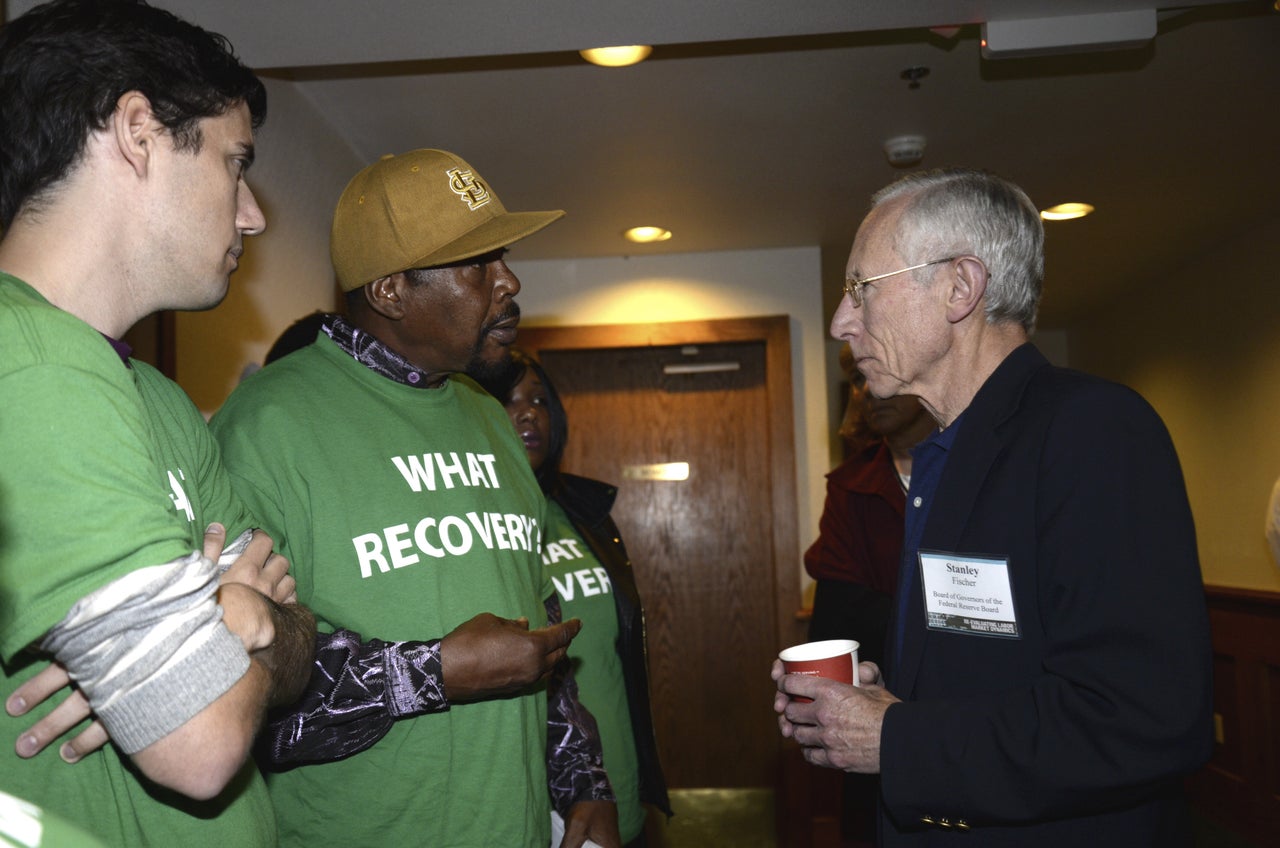
But beyond the intriguing visuals, the Fed Up activists’ message ― that working people in disadvantaged communities had not recovered from the recession ― got its first hearing. Their presence elicited the curious attention of news outlets unaccustomed to protests at the stately conclave, from The Washington Post and The New York Times to business networks like CNBC. And Yellen spoke to some of the demonstrators to assure them the Fed would take their concerns into account.
Fed Up soon replicated its efforts across the country, leading to meetings with all 12 presidents of the regional Federal Reserve banks and every member of the Federal Reserve Board of Governors in Washington, D.C. When a meeting with a regional Fed president proved elusive, a protest outside their doors would typically do the trick.
“With the Fed, they aren’t used to” protesters, Baker said. “You have 30 people show up at the Cleveland Fed, they go, ‘Oh fuck.’”
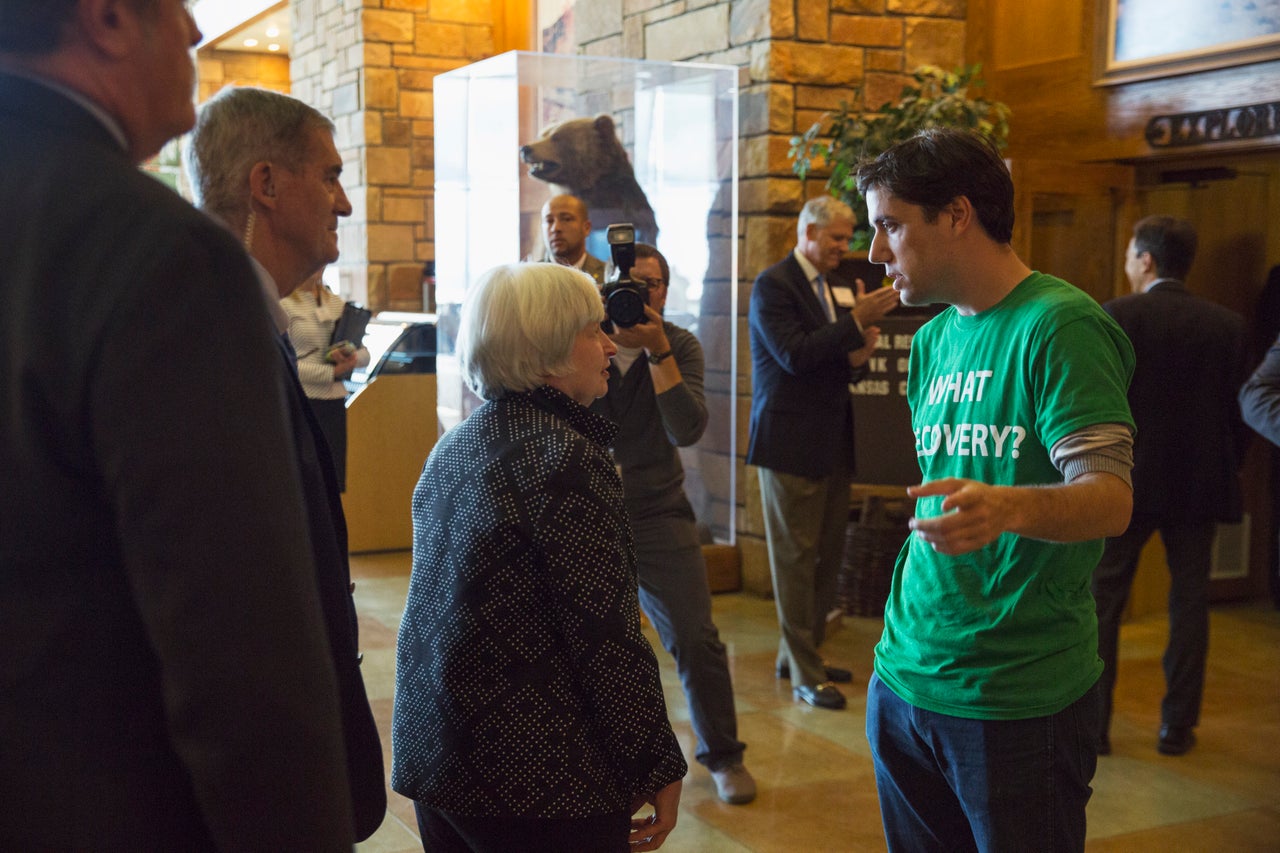
Fed Up’s success was a credit to Barkan’s innovative use of grassroots pressure tactics on one of the country’s most elite institutions. To make it work, he not only explained to low-income workers how the Fed affected their lives, but he could do it in fluent Spanish and switch back to English as needed.
As an Ivy League attorney and fluent policy wonk, Barkan acted as something of an interpreter between activists and the Fed officials and business reporters whose attention they sought.
“The story of the Fed Up campaign is a ringing endorsement for the power of creativity, rigor and love and organizing in some ways,” Friedman said, crediting Barkan’s ambition, humility and “commitment to listen and correct course as a result of what he’s hearing, not just from fancy-pants Washington thinkers but [from] community members and community leaders.”
Fed Up’s message had begun to creep through to Fed officials ― at least insofar as they began to resign themselves to the idea that they were no longer technocrats who could lock themselves away from the people whose lives they were affecting. Workers on the economy’s margins were the equivalent of constituents whose requests for meetings they had to grudgingly acknowledge. This culminated in the group’s third annual trip to Jackson Hole in August 2016, when no fewer than 11 Fed leaders, including Vice Chair Stanley Fischer, agreed to a discussion with some 100 Fed Up activists that would prove to be one of its most potent moments of advocacy.
The meeting was a sight to behold: The Fed Up activists in their green T-shirts had Federal Reserve leaders surrounded. It was like Barkan’s airplane conversation with Sen. Flake if there had been a dozen Barkans demanding answers for every Flake trying to answer them.
The event offered workers of color the opportunity to share their perspectives in the hopes of challenging some Fed officials’ belief that the economy had reached “full employment” and was thus due for an interest rate hike.
“Now, the economy has recovered for much of white America, but for black and Latino workers, it has not,” Rod Adams, an organizer with Minnesota Neighborhoods Organizing for Change, a Minneapolis-based Fed Up affiliate, told the room full of Fed Up officials and activists. “If you decide that we’re at maximum employment now and you intentionally slow down the economy, you’ll be leaving us behind, pulling up the ladder right after you’ve climbed it.”
At the Jackson Hole meeting, Fed Up activists like Adams showed a refreshing lack of “deference” to Fed officials, according to Levin, the former Fed economist.
“Fed officials often travel around the country giving speeches in big auditoriums. And sometimes there’s time for Q&A, but usually they’ve already got pre-prepared and pre-digested answers for those questions,” Levin said. “In that conversation at Jackson Hole, there was at least the start of community engagement.”
Prior to the advent of Fed Up, Federal Reserve officials had never been directly confronted by the actual humans who bear the consequences of the Fed’s discreet twiddling with its monetary dials. Evidently, a different sort of activism was needed in a political culture dominated by the people at the controls and their elected enablers and not the humans on the other end. As with his encounter with Flake, Barkan’s triumph in Jackson Hole was to force a frank confrontation between political actors and the acted-upon.
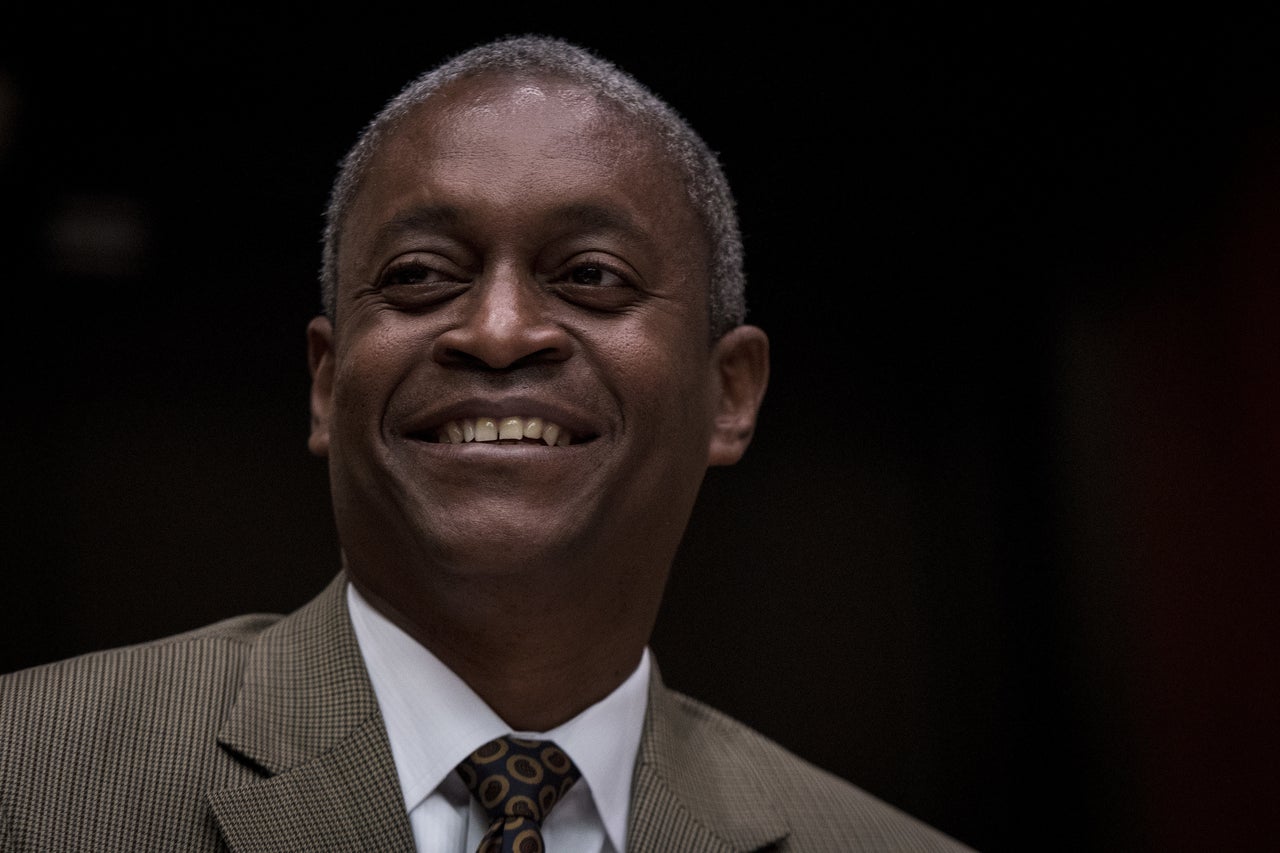
Succeeding Where Others Failed
It is difficult to know if Fed Up was responsible in some small way for postponing the Fed’s decision to raise interest rate hikes. Under Yellen’s leadership, the Fed had, in fact, raised rates at a much slower rate than prognosticators had expected in 2014 and 2015. In December 2015, the central bank enacted its first rate hike since December 2008, but then waited a whole year to do so again. Yellen always insisted, however, that decisions not to raise rates were based on economic data rather than outside pressures.
In the realm of increasing diversity and reforming Fed processes, however, Fed Up’s influence has been obvious. A February 2016 study published by Fed Up revealed that 83 percent of the board members of regional Fed banks are white, and that nearly three-quarters of them are men. It also found that just 11 percent of those board members come from consumer groups or community organizations, compared with 39 percent from the financial industry.
In recent months, the Fed has shown a growing willingness to address these concerns. In March, the Atlanta Fed bank announced the selection of economist Raphael Bostic as its president, making him the first black head of a regional Fed bank.
“I don’t think there’s any way on earth that would have happened” without the work of Fed Up, Baker said.
Then in June, the Fed published a major paper analyzing racial disparities in the job market that earned public praise from Bernstein.
That the Fed would begin taking racial inequality seriously “since Fed Up has been agitating,” Bernstein said, is not “a coincidence.”
“We’ve written academic papers and we’ve complained about some of the metrics they used, but [Barkan] did something about it and has been way more influential than people realize.”
- Jared Bernstein, Center on Budget and Policy Priorities
And Neel Kashkari, a Goldman Sachs alum whose November 2015 appointment as president of the Minneapolis Fed bank elicited jeers from Fed Up and other progressives, has emerged as one of the Fed’s most outspoken monetary policy doves. He voted against the three most recent interest rate hikes, noting the high black unemployment rate in a June blog post about his dissenting vote.
Were it not for Fed Up’s advocacy, “Kashkari would not be nearly as aggressive,” Baker maintained.
Fed Up’s influence was also evident in the 2016 presidential race, where first Sen. Bernie Sanders (I-Vt.) then former Secretary of State Hillary Clinton vied for the mantle of Fed reform.
In May 2016, Clinton promised to make the regional Fed banks more representative; a campaign spokesman revealed her plans to “get bankers off of Fed boards.”
“Ady not only recognized a deep problem that had been around for decades, but he managed to do something about it in a way that I never imagined,” Bernstein said. “We’ve written academic papers and we’ve complained about some of the metrics they used, but he did something about it and has been way more influential than people realize.”
Rachael King, Barkan’s wife, agreed that Barkan’s success with Fed Up was a clear model for his work trying to stop the tax bill.
“He saw how much of an impact that had on this incredibly arcane-seeming body like the Federal Reserve,” King recalled. “The Fed started talking about black and brown people at all of its meetings, how those communities are doing broken down in different segments. He has seen that that tactic can have a real impact.”
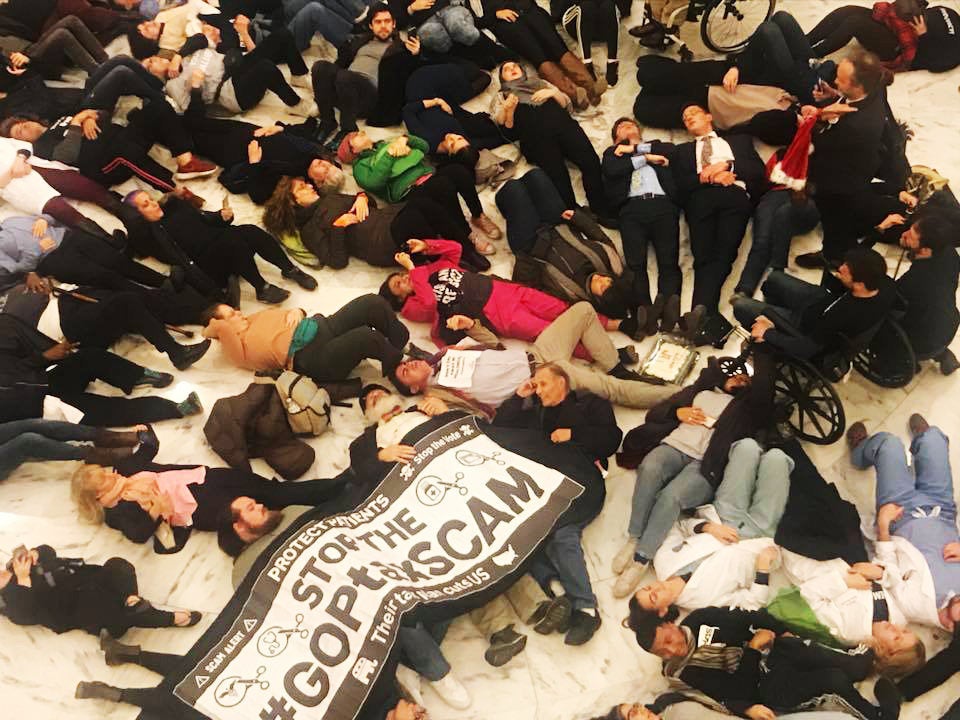
‘I Wanna Go Down Swinging, In A Blaze Of Glory’
As summer turned to fall in 2016, Barkan was living what many would consider an ideal life: He had personal edification and financial security thanks to his job at the Center for Popular Democracy, and King, his college sweetheart, had just given birth to their son Carl. Together, they were building a life in Barkan’s home state, where King had accepted a position in the English department at the University of California, Santa Barbara.
The future looked bright for Fed Up as well. All of the polls showed Hillary Clinton with a solid lead over Donald Trump. The upstart activism group was poised to have its first real ally in the White House.
Then, in October 2016, Barkan was diagnosed with ALS. The news hit him and his loved ones like a ton of bricks.
“It’s been really hard,” Barkan told HuffPost on Dec. 5. “It was totally unexpected, and it’s a really bad disease that they don’t have a real treatment and a cure for. But I’ve got to spend a lot of time with family and friends, which is great.”
King is certain that their son Carl will be a progressive firebrand like his father. But she acknowledged that “one of the things that is hard thinking about the future is whether Ady will be around to have those conversations with him and teach him how to be a political person, and how to have the right kind of politics.”
“One of the gifts of this moment right now is now we’re gonna have a lot of artifacts of Ady doing that as well; we’ll have videos and we’ll have these stories, so it will not be abstract,” she said.
Up until a few days before his first arrival in Washington, D.C., in early December, Barkan had kept news about his condition relatively private. Knowing that he could leverage his personal story to draw attention to the human impact of the GOP tax legislation, he decided to make the tax protests his public coming-out moment.
When HuffPost first caught up with him, Barkan was sitting on a bench in a playground just south of the U.S. Capitol. Dozens of activists who had bused in from around the country were preparing for the day’s demonstrations. His voice was clearer and calmer than it would ever be during the two weeks of meetings and shout-filled protests that would follow.
Rather than dwell on his condition, Barkan quickly navigated the conversation back to the tax bill fight, which he seemed to view with greater urgency. Speaking out against the tax bill was not just a matter of his own survival, though he believed it was, but the survival of democracy, equality and fairness ― the causes to which he has devoted much of his life.
The Trump administration and congressional Republicans are “undermining as best they can our economy and our society,” Barkan said. “And it’s worth being in the fight and trying to resist, because that’s how we build community and express our core values in our vision for the future.”
I asked Barkan why progressive mobilization against the GOP tax bill had thus far proven less effective than resistance to efforts to repeal the Affordable Care Act.
He dismissed the notion.
“The fight’s not over on the tax bill,” he said.
Indeed, it wasn’t. In a much shorter period of time than it took him to put the Federal Reserve on progressives’ radars, Barkan’s last-minute efforts to thwart the GOP tax bill generated a crucial national spotlight on the liberal and Democratic opposition to the legislation.

Until Barkan’s chance encounter with Flake on Dec. 7, progressive resistance to the tax bill had struggled to garner media attention and political momentum as similar protests against repeal of the Affordable Care Act had.
News outlets had duly reported the disproportionate benefits of the bill for the rich, prompting deep public disapproval of the legislation. But the debate had largely remained aloof from the human consequences of the bill.
Barkan’s compelling personal story and conversation with Flake momentarily appeared to change that, eliciting coverage in a range of national media outlets, from CNN to The New York Times. The Facebook live broadcast of Barkan’s meeting with Collins received over 100,000 views; the following night, he shared his appeal to a much larger audience as a guest on MSNBC’s “All In with Chris Hayes.”
Sens. Elizabeth Warren (D-Mass.) and Sanders, the two most progressive members of the Senate, also put their money on Barkan, featuring him in their eleventh-hour Facebook videos designed to stir up popular opposition to the tax bill.
Barkan’s story, reverberating in the national media, inspired others to put their bodies on the line. Jenson Larrimore, 36, drove up from Richmond, Virginia, to protest the tax bill after hearing Barkan “very succinctly” describe how it would deprive people of health insurance and set in motion cuts to Medicare and Medicaid. Larrimore, who was paralyzed from the waist down in a car accident 11 years ago, relies on Medicare and disability benefits.
“I would not have lived and survived to tell the tale in this house had it not been for Medicaid,” Larrimore told HuffPost before getting arrested as part of a die-in protest.
For his part, Barkan was determined to demand answers from Republican lawmakers until the last possible moment. After his meeting with Collins on Dec. 13, he and his family decided to stay in Washington, D.C., until the fight was over, one way or another. In all, he would be arrested on three separate occasions performing acts of civil disobedience on Capitol Hill.
With each passing day of advocacy, Barkan showed greater signs of exhaustion. His voice grew hoarser and his beard scragglier. He got around the halls of the Capitol almost exclusively in a wheelchair, and his slightly gnarled left hand often lay limp on his lap.
“I can joke or say honestly that if I’m gonna die really young, I wanna go down swinging, in a blaze of glory,” Barkan told HuffPost shortly before he returned to Washington. “It’s funny and true and tragic and poignant all at the same time.”
“The hand I’ve been dealt is the shit of ALS,” he added. “But I’ve also been dealt so many incredible cards, and I think the only thing I can do is play them to the best of my ability.”
On Dec. 18, wearing a black T-shirt that said “Democracy!” in white letters, Barkan celebrated his 34th birthday at the Capitol with a coterie of activists who had grown closer since the first waves of arrests began two weeks prior. Barkan’s friends brought more than one protest-themed cake for the occasion, but political rabble-rousing appeared to be gift enough for Barkan.
When Barkan heard Sen. Lindsey Graham (R-S.C.) speaking about Sen. John McCain (R-Ariz.) ― who, like Barkan, is terminally ill ― Barkan and Meghan Anderson, another wheelchair-bound demonstrator, tried to start a conversation with him. The Center for Popular Democracy captured their attempt on video.
“I’m dying, come on! I’m dying of a brain disease,” Barkan called hoarsely to Graham as he and Anderson rolled forward in their wheelchairs. But rather than respond, Graham rushed through a door and out of sight.
“You’re a coward, Senator Graham!” Barkan declared.
Recounting the incident on MSNBC, Barkan said that it “exemplified how Republicans are treating this legislation and treating the American people: They are afraid to see our humanity.”
“And if they were, in fact, to stop and look us in the eye and hear our voice, their legislative agenda would become untenable,” Barkan continued. “He doesn’t have the heart to look me in the eye and say, ‘Yes, I am voting to cut your Medicare. I am voting to raise your taxes so that real estate developers and hedge fund managers can get huge tax cuts.’”
At the day’s end, Barkan led the Occupy Wall Street-style call-and-response known as the “human mic” as activists around him prepared to participate in a die-in at the Russell office building rotunda. The theme of the human mic that night was “democracy” ― the word that had animated Barkan’s career as an activist.
“If senators run in fear from our stories,” he said, pausing to let his peers repeat the clause, “then our democracy is dying.”
Soon, like clockwork, came the arrests ― 64 in total. First, the U.S. Capitol Police warned them through a megaphone that they needed to move or risk arrest. When the activists refused, the cops approached demonstrators, bound their hands in plastic zip-tie handcuffs and carted them to the Capitol’s makeshift jail.
“This is what democracy looks like!” Barkan cheered with a smile, raising his bound wrists in the air as the police wheeled him away.

